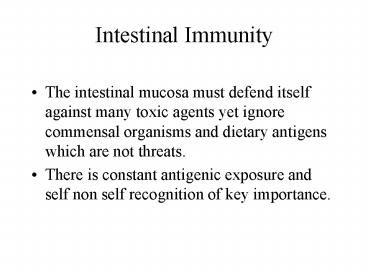Intestinal Immunity - PowerPoint PPT Presentation
1 / 9
Title:
Intestinal Immunity
Description:
... many toxic agents yet ignore commensal organisms and dietary antigens which are not threats. ... There is constant antigenic exposure and self non self ... – PowerPoint PPT presentation
Number of Views:37
Avg rating:3.0/5.0
Title: Intestinal Immunity
1
Intestinal Immunity
- The intestinal mucosa must defend itself against
many toxic agents yet ignore commensal organisms
and dietary antigens which are not threats. - There is constant antigenic exposure and self non
self recognition of key importance.
2
GALTGut Associated lymphoid tissue
- Peyers patches contain specialised
microfold(M)cells which transport antigens to the
underlying lymphoid tissue. - The remaining cells have tight junctions which
allow transport of water and ions but not
macromolecules(Digestive products?) - Rich mucosal surface containing glycocalix mucus
and IGA(40mg/kg body weight a day) - Closely packed microvilli also prevent pathogen
entry
3
M Cells
- Large particles such as bacteria enter by
phagocytosis - Viruses by endocytosis
- Direct delivery of pathogens to the immune
system. - Also shown to signal via interleukins to the
immune system. - Some pathogens (polio salmonella )use as route of
entry to the body.
4
Immune response Th1VS Th2
Th1
Th2
5
Th2
Th1
Childhood development and antigenic exposure
influences adult Th responses.
6
- Th 1 increase in bacteria and virus infection
- Th2 in response to parasites and initiate mast
cell deregulation and promote eosinophil
production. - Is IBD an inappropriate T cell response?
- Maybe if M cells loose their tight regulation of
substance transport.
7
Genetic Advances
- Chromosomes Genes DNA Protein
- Chromosome 6 interleukin antagonist and close to
MHC marker site also linked to site for TNFalpha
gene. - Chromosome1(CD)
- Chromosme3(CD)
- Chromosome5(cd)
- Chromosome12(UC)
- Chromosome 14(CD)
8
Chromosome16 NOD2 (CD)
- Nucleotide oligomerisation domain or CARD caspase
activating recruitment domain - Variants in 43 CD patients
- Early onset and ileal disease
- What does it do? Protein which regulates
inflammatory response to bacterial infection
recognises a protein in bacterial cell wall.
9
Other theories
- Under production and abnormnal mucus production.
- Microvasculature involvement
- Endothelin vasoconstrictor slows down leukocytes
and allows them to adhere to endothelium
potentiates inflammation - Metabolic cellular changes































